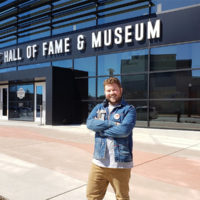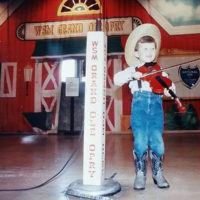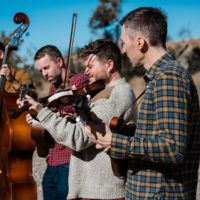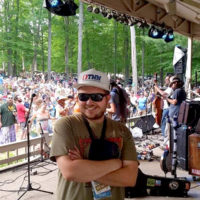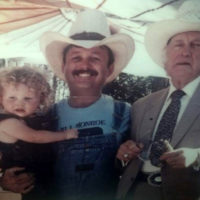
Danny Clark is a recent California re-transplant from Tennessee. Born in California, Danny spent his formative years supporting his family’s Bluegrass Bus Museum project, along with many other institutions, in the bluegrass state of Tennessee. I first met Danny and his folks at the John Hartford Memorial Festival right after he’d moved back to Southern California. In addition to being a great mandolin and fiddle player, Danny brings a wonderful history and exuberance to the California bluegrass state. We welcome him back with open arms.
Hi Danny. Let’s start at the beginning. Where did you grow up and when did you first hear bluegrass music?
I was born and raised in Orange, California, a community thirty miles south of Los Angeles. My father, Don Clark, made sure bluegrass was the first music that reached my ears. He turned off the radio in the car on the way home from the hospital, and once I arrived at home, he cranked the windup 78 rpm record player and dropped the needle on the Mercury cut of Flatt & Scruggs and the Foggy Mountain Boys playing Foggy Mountain Breakdown. I never stood a chance. When I was sixteen my family moved across the country to Nashville. I studied at East Tennessee State University in the bluegrass program before transferring to Middle Tennessee State University to finish my degree.
Tell us about your family’s involvement in bluegrass.
My father owns and operates the Bluegrass Bus Museum, a 1955 Flxible replica of the Martha White tour bus that Flatt & Scruggs traveled in during the 1950s and ’60s. My father also played banjo in a Southern California band called Crystal River. My mother, Linda Clark, works for a prominent merchandise company near Nashville that services hundreds of bluegrass and country artists. Hi Mom & Dad!
People love stories from the bus. Can you share some?
While driving down the road in that old bus you really stand out! I remember a fellow in Ohio who followed us for over sixty miles. We finally stopped at a diesel station and he spent fifteen minutes touring the bus. We can’t get out of a fuel station without a few people wanting to go inside. We’re the bluegrass version of the Oscar Mayer Wienermobile.
One time we were crawling through the desert going up a grade really early in the morning, and unbeknownst to us the driver of Marty Stuart’s bus noticed our 1955 Flxible slowly gaining on them. He woke up Marty and yelled “You got to look out the window!” As he opened the blinds we just rolled right on by. I seem to remember him saying that he felt like he woke up into a foggy mountain dream. There’s a tune idea for all you songwriters out there.
Will the bus ever make its way to California?
The museum started out in SoCal, and throughout the 1990s the bus was on display at many bluegrass events in California. At our peak period we displayed the museum at twenty five events per year, and traveled everywhere from Florida to Maine. Now the bus resides near Nashville and only goes to events within a hundred miles of its home base. The bus is in top-notch shape, but due to its age and the inability of finding parts we’ve decided to keep her close to home in Tennessee.
What instruments do you play, and what came first?
Around the age of five my parents enrolled me in classical violin lessons, and after a year I transferred into a country fiddle style class. Upon entering the bluegrass program at ETSU I took up playing the mandolin. In a band setting I prefer to play fiddle, but can switch to mandolin if needed.
You’re quite the bluegrass historian. Tell us about that.
I’ve always loved the history of bluegrass and country music. Through my tours in the Bluegrass Bus Museum I developed a lot of relationships with people who share that interest. I always recognized the importance of preserving these stories, even at a young age. While still in school I sought out people like Curly Seckler, Everett Lilly, Tater Tate, Lance Leroy, and many others and did casual recorded interviews. I later used my experience and connections gained through the Bluegrass Bus to segue into work at the International Bluegrass Music Museum, now known as the Bluegrass Music Hall of Fame & Museum, in Owensboro, Kentucky. I started as their marketing director and eventually moved into the position of registrar and worked within the curatorial department. I helped design and develop the permanent exhibits in the new museum.
I love the pictures you share. How many do you have?
Honestly, I don’t know. Somewhere in the thousands. These old items just seem to find me. Frequently people with artifacts will bring them to me. I have enough background knowledge and connections with other historians that I can authenticate the item and identify how that object fits into the greater story. I’ve also purchased photos and ephemera from friends, auctions, garage sales, and estate sales of those prominent in the music industry.
How did you come by your nickname “Hootenanny”?
The term hootenanny is associated with a very specific time period in the early-to-mid 1960s, when folk music entered the college and big city scene. Today the term ‘hootenanny’ has fallen out of fashion and has been replaced in bluegrass colloquialism with ‘picking party’ or ‘jamming.’ It also helps that hootenanny rhymes with my first name.
What’s your relationship with IBMA?
I was on the IBMA board of directors for four years.
What prompted your recent move from Tennessee to California, and how’s that going?
Working for the family company was the key reason for leaving Tennessee for sunny Southern California. Life in Cali is wonderful, and I’ve been welcomed with open arms from hundreds of people who pick and sing down here. I was worried about moving away from the music in Tennessee, but have found it surprisingly easy to jump into the robust local bluegrass community. I find myself playing more gigs here than I did in Nashville.
Tell us about your involvement with the CBA and the Southern California bluegrass scene.
I’m a card carrying, dues paying member of the California Bluegrass Association and the Southwest Bluegrass Music Association. There’s a percolating scene here in SoCal. Northern California gets a lot of credit for the quantity and quality of music they produce, and their robust youth programs have a lot to do with this, but I assure you that bluegrass is alive and thriving down south. Last year I established a relationship with the Summergrass Festival in Vista, near San Diego. I ran their street team and helped them with various promotional efforts. I look forward to helping them again with their 2020 event.
What bands are you in and what do you play?
I joined the Greasy Spoons as soon as I moved to SoCal. We’re a four-piece acoustic group that plays two-thirds original songs and one-third cover songs. With that band I play both fiddle and mandolin, but not at the same time. For the last few months the Greasy Spoons have been in the studio, and we expect to have a new album of all original material out before the end of the year. I also play fiddle and sing in a traditional bluegrass band called the Angel City Bluegrass Boys. As the name states, we’re all local to Los Angeles.
Who are your go-to bluegrass fiddlers?
For the vintage fiddlers I prefer Scotty Stoneman, Benny Martin, and Paul Warren. In the current category I dig the sounds of Jason Carter, Michael Cleveland, and Tim Crouch. My all-time favorite fiddler is Bobby Hicks. His double stops combined with his impeccable backup work is incredibly tasteful and pleasing to my ears. I encourage everyone to listen to Bobby’s kickoff off to Please Search Your Heart on the appropriately titled album California Connection by the Bluegrass Album Band.
What are your current favorite fiddle tunes?
Whenever I’m jamming I like picking Squirrel Hunters and Brown County Breakdown, and I recently started playing Durham’s Bull again. Tater Tate taught me a version of that back when I was a student at ETSU. I was lucky enough to record all my lessons with him before he passed away. Tater was the fiddler who taught that tune to Paul Warren.
Are you also an instructor?
Yes. During my tenure at the International Bluegrass Music Museum I taught fiddle and mandolin in their very popular Saturday lessons program. We also hosted the Pete Wernick Jam Camp, where I was an instructor to both individuals and groups. In my spare time I teach private lessons, and recently was the fiddle instructor at the Huck Finn Jubilee in Ontario, California.
What’s your involvement in the John Hartford Memorial Festival at Bean Blossom?
I’ve been involved with this festival for five years, and I’m their marketing director and festival archivist. You could say I wear a lot of bowler hats in that organization. I also play in the staff band, the John Hartford Volunteer Jug Band. We have one gig annually, we practice just once and play only one song each year. We exist to open the festivities of the John Hartford Memorial Festival. I stand behind this festival as one of the best. If you’ve never been, I suggest you check it out. It’s got a very laid back vibe and is full of campground pickers. We work incredibly hard to make sure we have an awesome picking culture at this event. That’s important to me that I help produce or attend as a fan.
What’s the future of bluegrass music?
I hope it will continue to progress while still allowing room for younger fans to seek out new artists who are playing in the styles of the classic bands. I like working for events that book with an open mind and have artists as varied as the Punch Brothers and the Karl Shiflett & Big Country Show on the same roster. Hook the youth on the contemporary varieties of bluegrass, and at the same time lead them back to the fold and give them the opportunity to hear the traditional music. There’s room for both!
What do you do when you’re not picking?
During the day I’m the marketing director for Reel Lumber Service. My great-grandfather started the company in 1932, and I’m the fourth generation to work there. On the weekends I can be found digging through crates in flea markets and antique stores trying to find 78s for my collection. I’ve found many vintage bluegrass and country western artifacts in little stores tucked away back in the rural areas of Tennessee, North Carolina, Virginia, and Kentucky. Since moving to SoCal I’ve found myself spending more time scouring eBay for old music junk.
What bluegrass event would you like to put on that has never been done before?
I’m itching to put on an indoor hotel jamming festival like SPBGMA, the Great 48, and Kentucky Fried Pickin’ in the Orange County area. One day I’d like to produce a live action musical play at a bluegrass festival that recreates a thirty minute episode of The Beverly Hillbillies. I know it would bring down the house and sell a lot of tickets.
Is there anything else you’d like to say?
Please check out the YouTube channel for the Bluegrass Bus Museum. My father recorded hundreds of hours of main stage festival performances from the 1980s to the mid-1990s. He also traded VHS tapes with a man from Bean Blossom, so we have a good representation of live music from all over the United States, and a lot of footage from the Fathers’ Day Festival in Grass Valley. The VHS tapes have been converted to DVD and I rip them into YouTube. Each video is carefully researched, and I make sure to include the date, location and names of each band member. We have vintage videos of Bill Monroe, the Bluegrass Album Band, Jim & Jesse, the Osborne Brothers, Alison Krauss & Union Station, the Del McCoury Band, the Seldom Scene, Larry Sparks, and many more. Right now there are around fifty videos on that channel, and I suspect by the time I’m done there will be thousands of live songs from festival and concerts all over the United States.
Check out my vintage finds by following me on Instagram @DannyHootenanny.
Thanks so much Danny, it’s been a hoot. Sorry, I couldn’t resist.
Goodness Gracious It’s Good. Sorry, I couldn’t resist.

